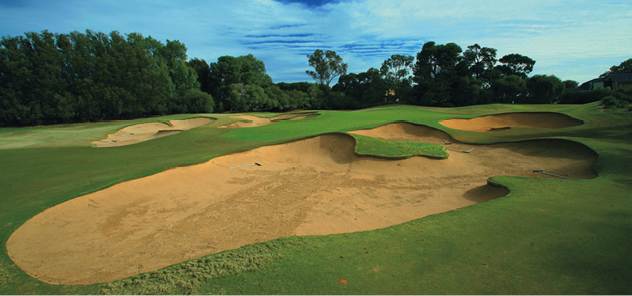
Kooyonga is a thinking player’s golf course. One of the game’s greatest strategists, Peter Thomson, gave an insight into what is required to play well at Kooyonga after winning the 1972 Australian Open here. ‘It needs to be played,’ observed Thomson, ‘with the head as much as the hands.’
The course may never have existed at all if not for a 1922 train strike in Adelaide. Herbert ‘Cargie’ Rymill, who’d designed the original Royal Adelaide layout in 1904, was forced to take a tram instead of a train for an outing at Henley Beach. Along the way he spotted a ‘for sale’ sign on a tract of swampland and sand dunes, known as May’s Paddock. Excited by what he saw, Rymill jumped off the tram and took a closer look. He reckoned it perfect land for a golf course. Two years later Kooyonga – named after Rymill’s beachfront home – opened for play.
Although the course had an abundance of natural timber, it was not considered a truly tight or strategically tough layout when it was chosen at the 11th hour to host the 1965 Australian Open. South African Gary Player tore the course apart with a pair of 62s. Jack Nicklaus managed a 63. Something had to give. In light of such scoring, the course was lengthened and many of its superbly manicured fairways narrowed, placing a greater premium on accuracy and strategy.
Nowadays, tall gums and pine trees frame each tight, undulating fairway. The greens are well-bunkered, and fast, with plenty of slope. The rolling landscape sets Kooyonga apart from the other top courses of the Adelaide sandbelt, and it is for this reason that some reckon it a better and more challenging layout than its highly rated neighbour Royal Adelaide.
The bunkers are outstanding: expansive in parts, and intimidating, typical of all great sand-based courses. The opening hole sets the tone. This 495-metre par-five follows a gentle dogleg right, where a large scheme of bunkers along the right edge of the driving zone dictate that the safest playing line is down the left. Players looking to start their round strongly can risk skirting the bunkers, thereby shortening the hole and bringing the green within range in two shots. The approach shot to a raised putting surface is hard to judge, and missing the green long or left makes saving par a tricky business.
Kooyonga’s shortest holes are another standout feature. The variation in both their length and the shots they demand is first-rate. The 180-metre 3rd is an absolute gem, a tough hole where on a windy day a fairway metal might be needed to reach the green. This shot must be threaded between five bunkers – three right, two left – and two grassy hollows surrounding the putting surface. It sounds straightforward, but the green is protected from the prevailing southerly breeze and club selection can be difficult.
The same can be said of the shortest hole – the 145-metre 14th – which boasts the most exposed green on the course. Ringed by four deep bunkers, the green is smallish and sits at a slight diagonal to your approaching tee shot.
Kooyonga is a private club but tee times are available for visiting golfers who are members of other clubs.
|
MEMORABLE HOLES 1st, 3rd, 6th, 11th, 14th, 17th and 18th WHERE TO GO May Tce, Lockleys, SA 5032 BOOK A ROUND (08) 8352 5444, www.kooyongagolf.com.au OTHER 120 GREAT COURSES NEARBY Royal Adelaide (5.4 km), Glenelg (6.5 km), The Grange (7.4 km) WHERE TO STAY The Kooyonga layout is 6 km from Adelaide’s CBD and its wide range of accommodation options, from motor inns to five-star hotels. BEFORE/AFTER YOUR ROUND If you are in need of some retail therapy, the Harbour Town brand direct outlet shopping centre is less than two minutes away. National and international name products are available at prices up to 50 per cent lower than retail. |
